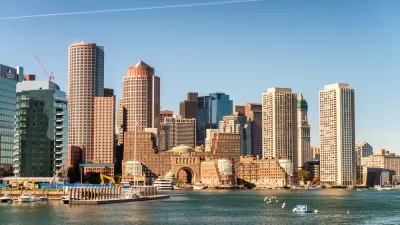An op-ed in the Boston Globe argues that the endless negotiations over new residential developments—including over the inclusion of affordable housing units—hurts the city's housing market.
Dante Ramos takes the example of the Copley Place—a 542-unit residential tower approved in 2013 by the Boston Redevelopment Authority, beset again and again by delays—to argue in favor of a much more relaxed regulatory environment.
Ramos explains his approach to supply and demand as follows:
In a tight housing market, every new unit helps — even units sold to 1-percenters at eye-popping prices. Today’s luxury unit is tomorrow’s fixer-upper. When private-equity barons and suburban empty-nesters buy into glitzy new condo towers, they’re not pushing up the cost of units in historic brownstones and older loft buildings. When middle-class professionals can afford existing units in the Back Bay and Beacon Hill, they aren’t bidding up prices in Roxbury, Dorchester, and South Boston.
According to Ramos's line of thinking, requiring developers to include affordable housing incurs unintended consequences that work at cross purposes with the affordable housing agenda:
This policy is ironic: States impose stiff cigarette taxes in part because they want fewer people to smoke; countries in Europe tax gasoline heavily to discourage unnecessary driving. Cities that need more market-rate housing should make it easier, not harder, to construct. When Houston officials concluded that there wasn’t enough housing downtown, they went as far as offering $15,000-a-unit incentives to persuade developers to build it."
Ramos is really calling for an end to the regulatory and legal mechanisms that enable NIMBYism, with more details from the Copley Place example and more strongly worded rhetoric included in the full article.
FULL STORY: Copley tower dispute shows how not to get more housing built

Trump Administration Could Effectively End Housing Voucher Program
Federal officials are eyeing major cuts to the Section 8 program that helps millions of low-income households pay rent.

Planetizen Federal Action Tracker
A weekly monitor of how Trump’s orders and actions are impacting planners and planning in America.

Ken Jennings Launches Transit Web Series
The Jeopardy champ wants you to ride public transit.

California Invests Additional $5M in Electric School Buses
The state wants to electrify all of its school bus fleets by 2035.

Austin Launches $2M Homelessness Prevention Fund
A new grant program from the city’s Homeless Strategy Office will fund rental assistance and supportive services.

Alabama School Forestry Initiative Brings Trees to Schoolyards
Trees can improve physical and mental health for students and commnity members.
Urban Design for Planners 1: Software Tools
This six-course series explores essential urban design concepts using open source software and equips planners with the tools they need to participate fully in the urban design process.
Planning for Universal Design
Learn the tools for implementing Universal Design in planning regulations.
Ada County Highway District
Clanton & Associates, Inc.
Jessamine County Fiscal Court
Institute for Housing and Urban Development Studies (IHS)
City of Grandview
Harvard GSD Executive Education
Toledo-Lucas County Plan Commissions
Salt Lake City
NYU Wagner Graduate School of Public Service





























